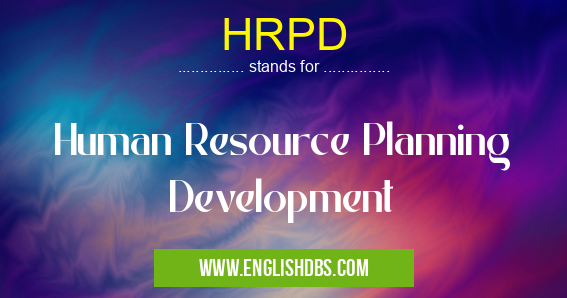What does HRPD mean in PLANNING
HRPD stands for Human Resource Planning Development, which encompasses the systematic and strategic process of assessing an organization's current and future human capital needs. This involves forecasting the demand for employees, identifying potential skill gaps, and developing strategies to attract, retain, and develop a talented workforce.

HRPD meaning in Planning in Governmental
HRPD mostly used in an acronym Planning in Category Governmental that means Human Resource Planning Development
Shorthand: HRPD,
Full Form: Human Resource Planning Development
For more information of "Human Resource Planning Development", see the section below.
» Governmental » Planning
Importance of HRPD
HRPD plays a crucial role in ensuring an organization has the right people with the necessary skills and competencies to achieve its business objectives. It helps organizations:
- Forecast labor market trends: Identify potential skill shortages and surpluses in the job market.
- Plan for future staffing needs: Determine the number and type of employees required to meet future business demands.
- Develop talent management strategies: Create programs and initiatives to attract, retain, and develop employees with critical skills.
- Optimize employee performance: Ensure employees have the necessary training and development opportunities to maximize their productivity.
- Enhance organizational agility: Adapt to changing business conditions and respond quickly to market demands by having a flexible workforce.
Key Elements of HRPD
HRPD typically involves the following key elements:
- Demand forecasting: Predicting future staffing needs based on business plans and industry trends.
- Skill gap analysis: Identifying the difference between current employee competencies and future requirements.
- Recruitment and selection: Attracting and hiring qualified candidates to fill open positions.
- Training and development: Providing employees with the necessary skills and knowledge to succeed in their roles.
- Performance management: Monitoring and evaluating employee performance to identify areas for improvement and recognition.
- Compensation and benefits: Establishing competitive compensation and benefits packages to attract and retain top talent.
Essential Questions and Answers on Human Resource Planning Development in "GOVERNMENTAL»PLANNING"
What is Human Resource Planning Development (HRPD)?
HRPD is a comprehensive process that aligns an organization's human capital with its strategic goals. It involves identifying and addressing current and future HR needs to ensure a workforce that meets the organization's objectives.
What are the key components of HRPD?
HRPD typically encompasses the following components:
- Workforce planning: Forecasting future labor demand and supply.
- Talent management: Developing, attracting, and retaining high-performing employees.
- Training and development: Enhancing employees' skills and knowledge to meet organizational needs.
- Career planning: Supporting employees in achieving their career goals while aligning with organizational objectives.
What are the benefits of implementing HRPD?
HRPD can provide several benefits, including:
- Improved organizational performance by aligning human capital with strategic objectives.
- Reduced turnover and increased employee engagement through effective talent management.
- Enhanced productivity and innovation through targeted training and development programs.
- Increased competitiveness by attracting and retaining a highly skilled workforce.
How can organizations successfully implement HRPD?
Successful HRPD implementation requires:
- Alignment with business strategy to ensure HR activities support organizational goals.
- Collaboration between HR and other departments to gather insights into future HR needs.
- Data-driven decision-making to base HR initiatives on objective analysis.
- Continuous monitoring and evaluation to track progress and adjust plans as needed.
What tools and technologies can support HRPD?
Various tools and technologies can assist in HRPD, such as:
- Human capital management systems: Centralizing and managing HR data, including workforce analytics.
- Learning management systems: Delivering online training and tracking employee progress.
- Collaboration platforms: Facilitating communication and knowledge sharing among HR professionals.
Final Words: HRPD is an essential function for organizations looking to optimize their human capital and achieve their strategic goals. By planning and developing a skilled and motivated workforce, organizations can gain a competitive advantage, enhance employee satisfaction, and ensure long-term success.
